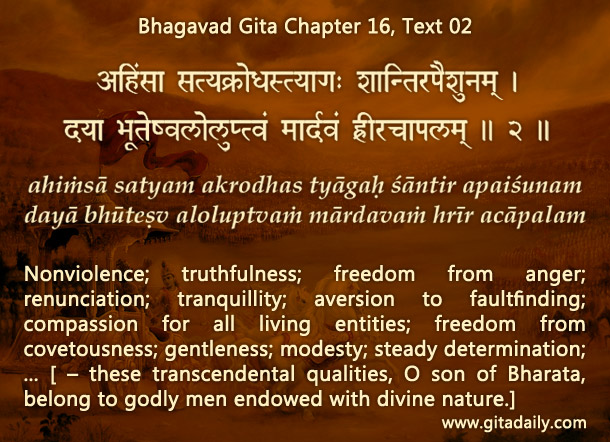Ahimsa, frequently translated as nonviolence, is a concept drawn from the Indian tradition that has gained widespread resonance in today’s world. The Bhagavad-gita, India’s foremost philosophical classic, offers a nuanced take on ahimsa that keeps in mind the world’s complex realities.
It commends ahimsa as a godly quality (16.02). In the Gita’s understanding, ahimsa refers not just to abstaining from physical violence; it also includes avoiding verbal violence. The Gita urges us to speak the truth in a way that is at least not unnecessarily agitating to others — and at best is pleasing to others (17.15). Here, pleasing speech doesn’t imply flattering or mollycoddling; it implies encouraging words and a morale-boosting tone. Intriguingly, in the Gita’s vision, the ambit of ahimsa goes further beyond physical and verbal violence; it also includes avoiding spiritual violence; this means not acting in a way that harms others’ spiritual interests and prospects.
Later (18.41-44), the Gita discusses virtues associated with different social roles. Therein, it (18.42) recommends a corollary of ahimsa, kshama (tolerance or forgiveness), as a personal quality to be cultivated, especially by the priestly. Simultaneously, it (18.43) recommends a differing, even opposing, virtue for those who are administrators: yuddhe capy apalayanam (not flinching or fleeing from a confrontation). Why the difference? Because these statements address different contexts.
In many interactions, nonviolence and forgiveness are much-needed virtues to avoid endless cycles of retaliation and escalation. Still, these virtues can’t comprise the default state policy toward wrongdoers or aggressors. The Gita acknowledges that we may sometimes be confronted with opponents who are relentlessly aggressive, even downright wicked. Forgiveness in the face of wickedness can be sheer foolishness. And if adopted as a state policy, such naive nonviolence can bring untold misery upon thousands, even millions, of citizens. For such situations, the Gita recommends unapologetic assertiveness as an essential deterrence.
One-sentence summary:
The Gita’s take on ahimsa blends nonviolence and deterrence: nonviolence for living harmoniously and deterrence for living safely.
Think it over:
- What is the ambit of ahimsa in the Gita’s vision?
- When is nonviolence a helpful virtue?
- When can nonviolence be counterproductive?
***
16.02: Nonviolence; truthfulness; freedom from anger; renunciation; tranquillity; aversion to faultfinding; compassion for all living entities; freedom from covetousness; gentleness; modesty; steady determination; … – these transcendental qualities belong to godly men endowed with divine nature.
To know more about this verse, please click on the image



Leave A Comment